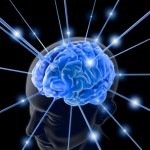Neuromodulation of the Prefrontal Cortex Can Reduce Energy Intake
Wednesday, November 18, 2015 Neuroimaging studies have implicated the left dorsolateral prefrontal cortex (LDLPFC), an area of the brain that plays an important role in the organization and planning of behavior including goal-oriented regulation of eating behavior and food choice, has been implicated in obesity.
Neuroimaging studies have implicated the left dorsolateral prefrontal cortex (LDLPFC), an area of the brain that plays an important role in the organization and planning of behavior including goal-oriented regulation of eating behavior and food choice, has been implicated in obesity.
Now Marci Gluck and colleagues, present a proof of concept study published in OBESITY, suggesting that effects of cathodal transcranial direct current stimulation (tDCS)aimed at the LDLPFC may reduce energy intake and promote weight loss in individuals with obesity.
The randomised sham-controlled study was conducted in 9 (3m, 6f) healthy volunteers with obesity, who were admitted as inpatients for 9 days to a metabolic ward.
In a first study, following 5 days of a weight-maintaining diet, participants received cathodal or sham tDCS (2 mA, 40 min) on three consecutive mornings and then ate ad libitum from a computerized vending machine, which recorded energy intake.
In a second study participants repeated the 1st study, maintaining original assignment to active (this time anodal) and sham.
In both studies, each stimulation session consisted of 40 min of anodal tDCS delivered with a neuroConn® DC-STIMULATOR device, at a constant current of 2 mA (with a 30-second ramp at on- and offset) using two 5 × 5 cm sponge electrodes soaked in a sterile 0.9% sodium chloride solution.
Participants who received active tDCS consumed about 700 fewer total kilocalories per day during anodal versus cathodal stimulation. This reduction in caloric intake was mainly a result of reduced fat and pop consumption.
In contrast, sham stimulation had no effect on energy intake.
As may be expected in this short term study, not much happened to body weight.
Regarding the mechanisms the authors speculate that,
“Our results, in combination with previous work, point to a role for the LDLPFC in energy intake and body weight regulation. However, the mechanisms that mediate this association are not clear. Capacity for self-control in reward-related decision-making tasks depends critically on the activity of the DLPFC, a region that is activated in response to cues that induce food craving…. Thus, anodal tDCS over the LDLPFC could have reduced food intake by simultaneously suppressing food cravings and facilitating choices requiring delayed gratification.”
As the authors optimistically conclude,
“In this proof of principle clinical trial, participants with obesity receiving anodal versus cathodal tDCS to the LDLPFC tended to have lower ad libitum energy intake, less fat and soda intake, and significant differences in weight change. “
Obviously, it will take longer term studies as well as further exploration of the type of patient who may benefit from this type of treatment, before we can judge whether this type of treatment (which appears to be otherwise safe) can play a role in obesity management.
@DrSharma
Vienna, Austria


